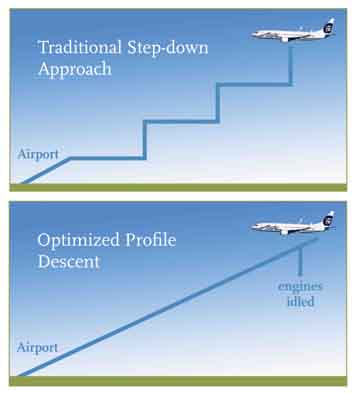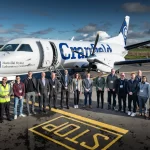 Alaska Air graphic
Alaska Air graphicAlaska Airlines demonstrated next-generation GPS-aided flight procedures last week (July 23) during a test flight over Puget Sound, Washington, that burned less fuel and reduced emissions by 35 percent compared to a conventional landing.
The flight was part of Alaska Air Group’s “Greener Skies” project at Seattle-Tacoma International Airport (Sea-Tac) focused on using satellite-based guidance technology to fly more efficient landing procedures that will reduce environmental impacts in the region.
Alaska Airlines demonstrated next-generation GPS-aided flight procedures last week (July 23) during a test flight over Puget Sound, Washington, that burned less fuel and reduced emissions by 35 percent compared to a conventional landing.
The flight was part of Alaska Air Group’s “Greener Skies” project at Seattle-Tacoma International Airport (Sea-Tac) focused on using satellite-based guidance technology to fly more efficient landing procedures that will reduce environmental impacts in the region.
The airline, in cooperation with the Port of Seattle, Boeing and other airlines serving Sea-Tac, is seeking Federal Aviation Administration (FAA) approval for the procedures, which could ultimately be used by all properly equipped carriers at Sea-Tac. Testing for the project began last summer and, since then, Alaska Airlines has flown two other demonstration flights and submitted more than half of the proposed procedures for FAA review.
Representatives from Alaska, Boeing, the FAA and the Port of Seattle participated in the most recent demonstration to observe the level of flight path precision and fuel consumption on eight landing approaches in a Boeing 737-700. With a landing weight similar to that of a typical passenger flight, the shorter and more efficient approaches reduced carbon emissions and saved 400 pounds of fuel per approach, according to Alaska Air.
The test flight used Required Navigation Performance (RNP) to fly more direct, continuous descent approaches. Typically, commercial aircraft follow a lengthy approach pattern and series of stair-step descents before landing. Using RNP technology and a continuous descent, also known as an optimized profile descent (OPD), aircraft can descend from cruise altitude to an airport runway along a shorter, more direct flight path at low power.
Alaska Airlines estimates that the new procedures at Sea-Tac will cut fuel consumption by 2.1 million gallons annually and reduce carbon emissions by 22,000 metric tons — the equivalent of taking 4,100 cars off the road every year. RNP will also reduce overflight noise for an estimated 750,000 people living below the affected flight corridor.
“Sea-Tac is the ideal location to pursue this cutting-edge project,” said Ben Minicucci, Alaska’s chief operating officer. “Seattle has the highest percentage of advanced RNP-equipped planes in the nation. . . . Ultimately this project could serve as a blueprint for next-generation aviation technology throughout the country.”
Alaska Air began using RNP in June 1996 to provide air service to Juneau, Alaska, where terrain and weather phenomenon had previously made it difficult to provide regular service. RNP provides computer-plotted landing paths by using a combination of onboard navigation technology and the GPS positioning. Alaska Airlines currently uses FAA-approved RNP procedures at 23 U.S. airports.
Alaska Airlines says it is the only major U.S. air carrier with a completely RNP-equipped fleet and fully trained crews and is also the first airline approved by the FAA to conduct its own RNP flight validation. Horizon Air’s fleet will be fully RNP-equipped by the end of 2011.
RNP and OPDs are part of the Next Generation Air Transportation System, the FAA’s plan to modernize the National Airspace System through 2025. This initiative will increase airspace capacity and efficiency while improving safety and reducing environmental impacts through the replacement of legacy ground-based equipment with new satellite-based technology and aircraft navigation capabilities.
The FAA accelerated its move toward a Next Generation Air Transportation System (NextGen) earlier this year with contracts awarded to Boeing, General Dynamics, and ITT to demonstrate NextGen procedures in real time on a large scale within the current air traffic system.
Planning and testing of the procedures will continue through the remainder of the year and will be integrated into Alaska Airlines and sister carrier Horizon Air’s commercial operations at Sea-Tac pending FAA approval.





